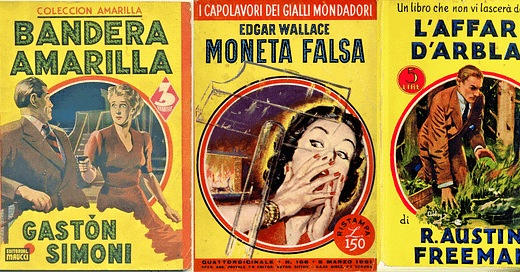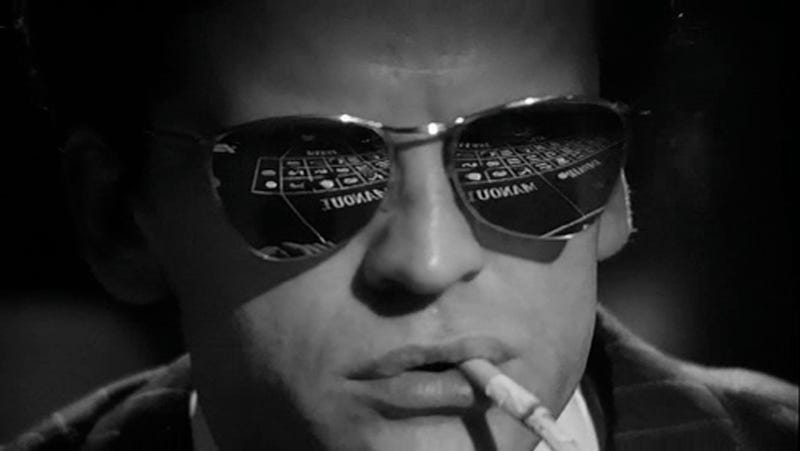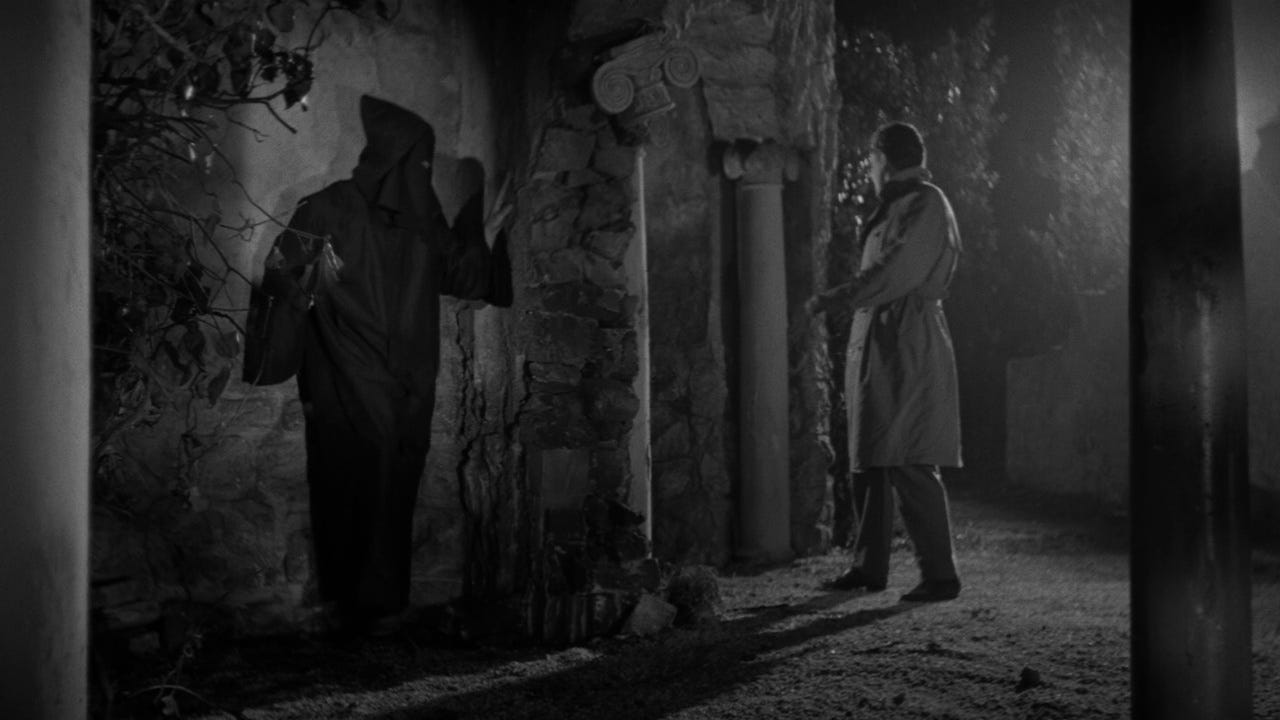Something sinister came alive in the 1960s. While neither canon nor universally agreed upon, Italian director Mario Bava’s 1963 film The Evil Eye (also released as The Girl Who Knew Too Much) likely birthed a unique and uniquely European take on the mystery genre. Known as giallo, this film genre took the classic hallmarks of mystery literature and film and added graphic depictions of sex and violence. Unlike the locked room potboilers of Agatha Christie or the hardboiled fare of Raymond Chandler, these films often show things from the murderer’s perspective. Black leather gloves and a sharp kitchen knife are more common than a magnifying glass and pipe. Thus, giallo is a true crossover genre that mixes mystery and horror. And it was created and perfected by Italians. There is no argument about that.
At the same time, another likeminded genre enjoyed a popular reception at the cineplex. The krimi actually coalesced earlier than giallo in the late 1950s. However, this West German film genre hit its stride in the mid-1960s. Like the giallo genre, the krimi is a innovation working within the mystery field. A krimi is a krimi if it has the following characteristics according to Birth.Movies.Death:
A plot involving a group of individuals harboring a secret, being targeted one-by-one for blackmail and/or murder;
A masked killer whose identity will be revealed by the end of the film;
A devil-may-care protagonist investigating the killer and its victims;
A plot that takes us from London to some type of manor or castle in the English countryside;
A protagonist’s sidekick who exists only for broad comic relief;
Klaus Kinski.
The first film of this kind debuted in 1959. The Fellowship of the Frog features a masked criminal and a gang of henchmen who resort to murder in order to keep their lucrative criminal activities from being disrupted by the police. The Fellowship of the Frog, and indeed the entire krimi genre, never shied away from acknowledging its pulp roots. Most krimi films proudly display the name “Edgar Wallace” somewhere in the tagline or title, and many of them begin with “Hier spricht Edgar Wallace” (“This is Edgar Wallace speaking”). Wallace, the English pulp writer responsible for the source material for most of the krimi films, played a hand in influencing giallo films as well. Both genres are essentially derived from the pulps—pulp stories, pulp aesthetics, and pulp attitude.
The genesis of the krimi and giallo stretches back to the pre-World War II era. In the 1920s and 1930s, European publishers began translating popular British and American crime and mystery stories. Italian publishing house Arnoldo Mondadori Editore, today the largest publishing conglomerate in Italy, led the way in 1929 with the creation of a separate line of pulp novels called Il Giallo Mondadori. Giallo, the Italian word for “yellow,” comes from the packaging of these pulp novels, which always featured exciting covers bound in a yellow paperback jacket. The first giallo book published was a translation of S.S. Van Dine’s The Benson Murder Case. Afterwards, a flood of British and American translations hit the Italian market, along with native-born works by Augusto de Angelis (Italian readers overwhelmingly preferred imports). These cheap paperbacks flew off the shelves. The popularity of gialli novels drew the unwanted attention of Mussolini’s government. In 1937, the Ministry of Popular Culture stipulated that all future gialli would have foreign murderers (“the murderer must absolutely not be Italian”) and successful conclusions (“[the murderer] cannot escape justice in any way”). The government also mandated that the following warning be placed on every edition:
Gli usi e i costumi della polizia descritti in quest’opera non sono italiani. In Italia, Giustizia e Pubblica Sicurezza sono cose serie. (The police’s customs and methods here described are not Italian. In Italy, justice and public safety are serious things.)
Despite these handicaps, the little yellow books continued to sell like crazy. A similar sensation struck in Weimar and National Socialist Germany. Translated crime novels proved wildly popular there too. The author most beloved by German readers, Edgar Wallace, was once upon a time one of the most popular authors in the English language. During his heyday in the 1920s, Wallace churned out an astonishing 130 novels (he published 18 in 1926 alone), forty short story collections, twenty-five plays, and fifteen works of non-fiction. People at the time joked that every Anglophone household had two books: the Bible and an Edgar Wallace.

Wallace came into the world in 1875 as the product of a one-night-stand between two London stage actors. Raised in foster care, Wallace eventually alighted to South Africa during the Second Anglo-Boer War (1899-1902). Here, Wallace landed his first writing job as a newspaper editor. In 1904, Wallace became a war correspondent covering the Russo-Japanese War (1904-1905). When he finally returned home to England sometime around 1905, Wallace threw himself into the mystery writing craft. He earned success with his crime novel The Four Just Men, a slim volume that provided the blueprint for many subsequent novels. Secret and often masked organizations, amateur sleuths, tough heroines, and a suggestion of the supernatural—these are the elements that made Wallace enormously popular and influential during his lifetime. Given the sensationalism of these plots, it made sense that Hollywood saw opportunities in Wallace’s material. The author eventually wrote directly for the cinema. His most famous contribution was the first draft of the screenplay for King Kong (1933). Although Wallace’s ideas did not make it to the screen, the film’s producers still saw value in listing his name in the opening credits. Wallace passed away the following year in 1932 at the age of fifty-six. During his life and after his death, Wallace’s work inspired stage plays and adaptations in Germany, with The Frog being one of the more popular examples.
Armed with these influences, as well as inspiration from American film noir and the pulp-influenced Expressionist crime films of Fritz Lang, the krimi and giallo film genres dominated pulp cinema in Europe between 1959 and 1975. They have in turn influenced multiple generations of directors and authors. Here then is a short, sharp, and simple rundown of the best krimi and giallo films for anyone looking to get started in this lurid world of sex, blood, and investigations.
Krimi
The Fellowship of the Frog (1959). Directed by Harald Reinl and starring Joachim Fuchsberger, Siegfried Lowitz, and Elfie von Kalckreuth.
The Black Abbot (1963). Directed by Franz Josef Gottlieb. Film stars Joachim Fuchsberger, Klaus Kinski, and Grit Boettcher. Plot involves a supposedly haunted former abbey that hides a secret treasure. Once a murderer in a black robe begins stacking bodies, the police arrive on the scene.
Circus of Fear (1966). Directed by Werner Jacobs and John Llewellyn Moxley. Film stars Christopher Lee, Margaret Lee, and Leo Genn. Shot at Hammer Film’s Bray Studios, this Anglo-German co-production concerns a deadly armored car robbery gang that tries to evade capture by joining Barberini’s Circus.
The Terrible People (1960). Directed by Harald Reinl. Film stars Joachim Fuchsberger, Karin Dor, and Fritz Rasp. The ghost of an executed criminal returns to London to exact revenge on those who did him wrong.
The 1,000 Eyes of Dr. Mabuse (1960). Directed by Fritz Lang. Film stars Dawn Addams, Peter van Eyck, and Werner Peters. The immortal German master-criminal Dr. Mabuse uses esoteric World War II technology to steal nuclear secrets from an American industrialist visiting West Germany.
Giallo
Blood and Black Lace (1964). Directed by Mario Bava. Film stars Cameron Mitchell, Eva Bartok, and Thomas Reiner. An Italo-German co-production, this sleek murder story concerns a masked serial killer hunting fashion models in search of a scandalous black book.
The Fifth Chord (1971). Directed by Luigi Bazzoni. Film stars Franco Nero, Silvia Monti, and Wolfgang Preiss. A journalist must clear his name after he is implicated in a series of murders.
All the Colors of the Dark (1972). Directed by Sergio Martino. Film stars George Hilton, Edwige Fenech, and Ivan Rassimov. After a car accident leads to a miscarriage, a woman begins believing that she is the target of a shadowy group of Satanists.
Torso (1973). Directed by Sergio Martino. Film stars Suzy Kendall, Tina Aumont, and Luc Merenda. A series of ghastly coed murders strikes the university city of Perugia. The sadistic sex killer eventually traps several women in a rural farmhouse.
Deep Red (1975). Directed by Dario Argento. Film stars David Hemmings, Daria Nicolodi, and Gabriele Lavia. Following the murder of a psychic, a journalist and jazz pianist work to uncover the true identity of a crazed killer targeting the city of Turin.
These are by no means exhaustive lists. These are merely meant to get your feet wet in something slightly darker than water. All PVLP KVLTISTS should be conversant in these genres, as they exude pure pulp. Don’t miss out, and don’t skimp. Feast on murder most Euro by giving these genres a chance, preferably after dark.








The giallo and the krimi have been formative viewing for me as a young filmmaker. The daring style, twisting plots, and provocative executions (both figuratively and literally) are inspiring and entertaining in equal measure. Personal favorites in both genres include 1982's "Tenebrae," 1964's "The Monster of London City," and 1970's "The Forbidden Photos of a Lady Above Suspicion." Great overview!
THIS is the kind of history I love.